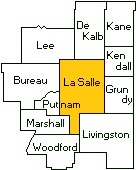
One of the oldest grist mills of Northville township, La Salle county,
Illinois, was built by John Sweet.
It was located on the west bank
of Somonauk creek, one hundred twenty-five feet north of the bridge, on the
same crossroad commonly known as the Scheidecker road, which is about three
miles south and one and one-quarter miles east of Somonauk.
Mr. and
Mrs. John Sweet and their family of two daughters moved from Ohio to
Illinois and lived in a log cabin which was on the land he purchased to
build the mill upon.
Before Mr. Sweet built this larger mill, he
operated a smaller mill that he built in the year of 1840. This mill stood
west of the larger mill.
After two years' work on the larger mill
and race it was completed in 1860. This wooden structure was thirty feet
square and two stories high, with a run of two stone burrs, which were four
feet in diameter and twelve inches thick.
This mill was propelled by
water power, but did not have the old style over-shot wheel. This wheel was
placed in a flat position. The water poured in at the side of the wheel,
which caused the wheel to turn in a whirling motion.
The foundation
of this mill, which was three feet above the ground, was built of stone
hauled from Andrew Brodie's quarry, which was located near Millington.
The course of the mill race was surveyed by Orange Potter, a county
surveyor and school teacher, who came from New York in 1835. The millrace
was about one-half mile loner and had a twenty-one foot water fall.
The mill race was dredged with teams and dump scrapers, with the exception
of one place where it was tunneled through a large hill. This tunnel was dug
by John Erb, a Frenchman who came to the United States in 1844. He was
commonly known to the old settlers as "Old Hontz." The tunnel was cribbed
with planks from the Scheidecker saw mill, which was in operation at that
time, located about one and one-quarter miles northeast from the grist mill
on the same stream.
In full flow the race was from seven to eight
feet deep, and from fifteen to sixteen feet wide at the top.
The dam
that was built across the creek to force the water through the race was
built of logs, stones, gravel and earth.
After the millrace was
dredged and completed, an argument came up among some men of the community.
Some said that when the creek would be dammed the water would overflow the
banks of the millrace, and very much doubted the surveyor's figures. But,
alas! when the day came to flow the water through the race it was proven
that the water line was just as the surveyor claimed it would be.
After Mr. Sweet had progressed thus far he was short of funds and had to
borrow money to install his machinery and equipment in the mill. He also had
no funds with which to buy wheat to grind on a large scale and sell flour to
merchants. He depended upon custom grinding, as this was a toll mill. An
eighth of every grist was reserved for grinding and labor.
Another
thing that interfered with Mr. Sweet's patronage was the falling of the
bridge over the creek on that crossroad. The piling rotted out under one end
and the bridge fell down. Therefore there was no way to get to the mill from
the east side for some time.
During the time the mill was in
operation by grandfather, Charles Rohrer, who was a young lad at that time,
often went fishing in the millrace, as fishing was good there then.
After the mill had been built about eighteen or nineteen years, it burned
down. My grandfather Henry Suppes was the loser of three sacks of wheat.
Other patrons lost grain, also. The burning of the mill was not a total
loss to Mr. Sweet for his property was heavily insured.
Not many
years ago the foundation of the mill was still in the ground where it was
laid. But on May 1st, when I visited the site, I discovered that the stones
had been taken up, probably to be used for some other purpose, and the
trenches were nearly filled and grown over with sod.
The millrace is
now quite filled in, and at the present time the east bank and caved-in
tunnel are used for a roadway for land owners to drive to their timber lots,
as several farmers each own a few acres of timber beyond the millrace.
After Mr. Sweet had completed the mill and race, he built a one-story
frame house where the log cabin had been standing. This house is still
standing today, and is the residence and property of Mr. and Mrs. George
Bolden, and the mill site and race are owned by the William George estate.
Extracted 08 Nov 2018 by Norma Hass from Stories of Pioneer Days in La Salle County, Illinois, by Grammar Grade Pupils, published in 1932, page 15.
| Lee | DeKalb | Kane |
| Bureau |
 |
Kendall |
| Putnam | Grundy | |
| Marshall | Woodford | Livingston |

